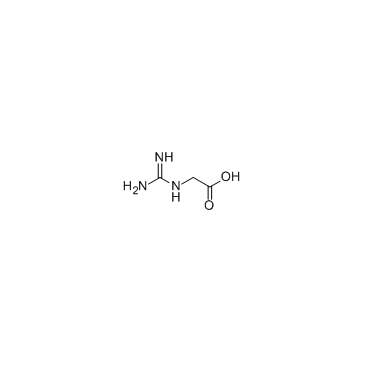2-Guanidinoacetic acid

2-Guanidinoacetic acid structure
|
Common Name | 2-Guanidinoacetic acid | ||
|---|---|---|---|---|
| CAS Number | 352-97-6 | Molecular Weight | 117.107 | |
| Density | 1.6±0.1 g/cm3 | Boiling Point | 294.2±42.0 °C at 760 mmHg | |
| Molecular Formula | C3H7N3O2 | Melting Point | 300 °C(lit.) | |
| MSDS | Chinese USA | Flash Point | 131.7±27.9 °C | |
|
High-throughput tandem mass spectrometry multiplex analysis for newborn urinary screening of creatine synthesis and transport disorders, Triple H syndrome and OTC deficiency.
Clin. Chim. Acta 436 , 249-55, (2014) Creatine synthesis and transport disorders, Triple H syndrome and ornithine transcarbamylase deficiency are treatable inborn errors of metabolism. Early screening of patients was found to be beneficial. Mass spectrometry analysis of specific urinary biomarker... |
|
|
Detection of autosomal dominant polycystic kidney disease by NMR spectroscopic fingerprinting of urine.
Kidney Int. 79(11) , 1244-53, (2011) Autosomal dominant polycystic kidney disease (ADPKD) is a frequent cause of kidney failure; however, urinary biomarkers for the disease are lacking. In a step towards identifying such markers, we used multidimensional-multinuclear nuclear magnetic resonance (... |
|
|
Dimethylglycine accumulates in uremia and predicts elevated plasma homocysteine concentrations.
Kidney Int. 59(6) , 2267-72, (2001) Hyperhomocysteinemia is a risk factor for atherosclerosis that is common in chronic renal failure (CRF), but its cause is unknown. Homocysteine metabolism is linked to betaine-homocysteine methyl transferase (BHMT), a zinc metalloenzyme that converts glycine ... |
|
|
Three-dimensional quantitative structure-activity relationship analyses of substrates of the human proton-coupled amino acid transporter 1 (hPAT1).
Bioorg. Med. Chem. 19 , 6409-18, (2011) The proton-coupled amino acid transporter hPAT1 has recently gained much interest due to its ability to transport small drugs thereby allowing their oral administration. A three-dimensional quantitative structure-activity relationship (3D QSAR) study has been... |
|
|
Elevated levels of plasma lipofuscins in patients with chronic renal failure.
Arch. Int. Physiol. Biochim. 96(5) , 211-21, (1988) The fluorescence excitation and emission spectra observed in plasma from patients with chronic renal failure were reproduced by the generation of soluble lipofuscins in normal plasma samples by incubation with mixtures of L-dopa, dopamine, L-norepinephrine, L... |
|
|
Liquid-chromatographic determination of guanidino compounds in plasma and erythrocyte of normal persons and uremic patients.
Clin. Chem. 27(11) , 1899-902, (1981) We describe a method for determination of guanidino compounds in plasma and erythrocytes. The compounds are separated by liquid chromatography, the concentrations in the effluent being estimated fluorometrically (Trans. Am. Soc. Artif. Intern. Organs 24: 61, ... |
|
|
Treatment of arginase deficiency revisited: guanidinoacetate as a therapeutic target and biomarker for therapeutic monitoring.
Dev. Med. Child Neurol. 56(10) , 1021-4, (2014) Hyperargininaemia is a disorder of the last step of the urea cycle. It is an autosomal recessive disease caused by deficiency of liver arginase-1 and usually presents later in childhood with progressive neurological symptoms including marked spasticity. In co... |
|
|
Living without creatine: unchanged exercise capacity and response to chronic myocardial infarction in creatine-deficient mice.
Circ. Res. 112(6) , 945-55, (2013) Creatine is thought to be involved in the spatial and temporal buffering of ATP in energetic organs such as heart and skeletal muscle. Creatine depletion affects force generation during maximal stimulation, while reduced levels of myocardial creatine are a ha... |
|
|
Simultaneous determination of guanidinosuccinic acid and guanidinoacetic acid in urine using high performance liquid chromatography/tandem mass spectrometry.
Anal. Chim. Acta 677(2) , 169-75, (2010) We present a method for the simultaneous determination of guanidinosuccinic acid (GSA) and guanidinoacetic acid (GAA) from urine by protein precipitation and liquid chromatography/tandem mass spectrometry. The chromatographic separation was performed using a ... |
|
|
Partitioning of [methyl-3H]methionine to methylated products and protein is altered during high methyl demand conditions in young Yucatan miniature pigs.
J. Nutr. 143(6) , 804-9, (2013) Methionine is the main source of methyl groups that are partitioned to synthesize various methylated products including creatine, phosphatidylcholine (PC), and methylated DNA. Whether increased methylation of 1 product can divert methionine from protein synth... |